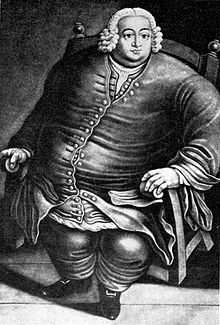Edward Bright

Edward Bright (1721–1750)[1] was a grocer in Maldon, Essex, England — known as the "fat man of Maldon"[2] — who was reputed at the time of his death in 1750 to be the "fattest man in England". He lived in a house on Maldon's High Street, and is buried in Maldon's Church of All Saints.
Bright weighed 47.5 stone (665 lb or 302 kg).
His coat was said to be large enough to have seven men stand inside it, although this is also sometimes stated as seven hundred men because of a tale[3] in which a man in a local pub (hotel) tempted a gambler with a bet that "seven hundred men" would fit into Edward Bright’s waistcoat. The bet was accepted. The gambler lost, because seven men from the Dengie Hundred (a parcel of land) fit into the waistcoat.
His portrait was painted in 1750 by David Ogborne (1700–1768), after whose painting various etchings[4] were published, including:
- 1750 - Irish engraver James McArdell (1728–1765)
- 1751 - Anthony Walker, published by John Hinton
In 2000, a bronze relief[5] of seven men in Bright's coat, by sculptor Catharni Stern,[6] was installed at the King's Head Centre off Maldon's High Street, near Bright's former home.
See also
References
- ↑ Some references have the year of his death as 1756.[citation needed]
- ↑ Edward Bright - the fat man of Maldon, accessed 7 December 2010
- ↑ Maldon and Dengie Hundred Group, accessed 7 December 2010
- ↑ Edward Bright, National Portrait Gallery (United Kingdom), accessed 15 February 2007
- ↑ Image of Stern's bronze relief accessed 7 December 2010
- ↑ Maldon: Bronze of Fat man's coat, Evening Gazette, accessed 7 December 2010